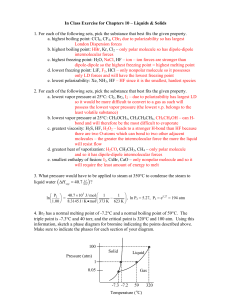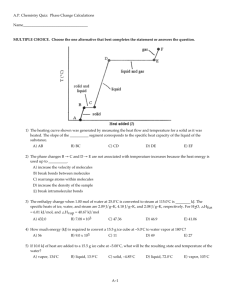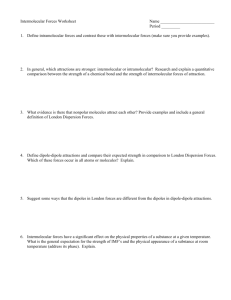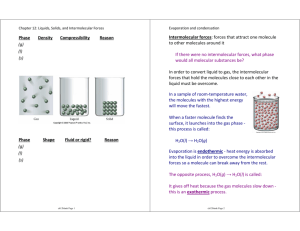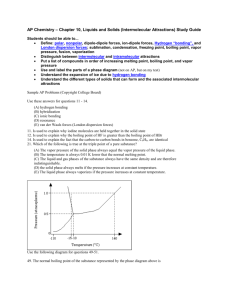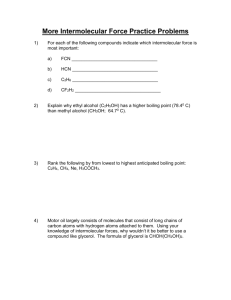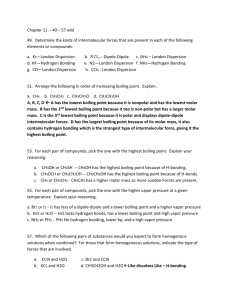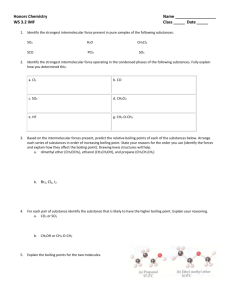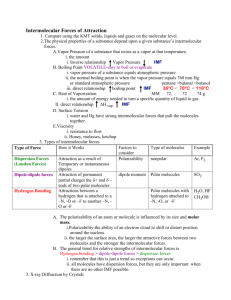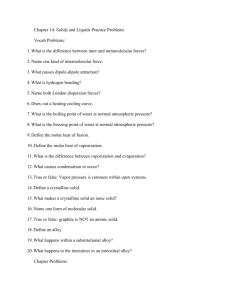A.P. Chemistry Practice Test: Ch. 10
advertisement
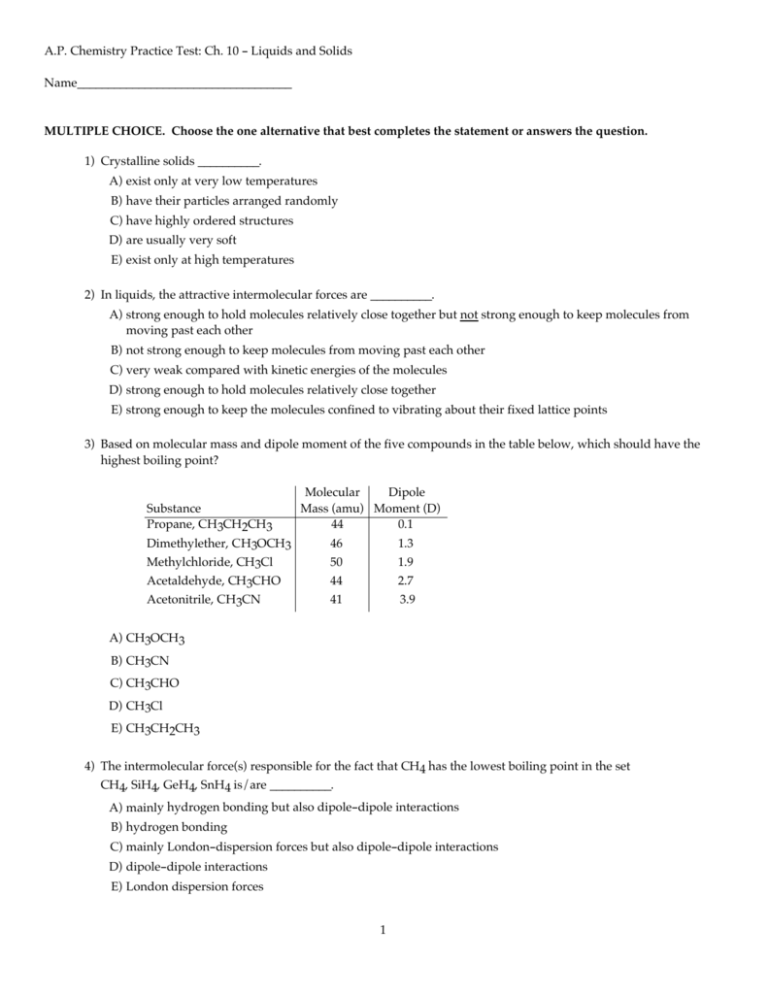
A.P. Chemistry Practice Test: Ch. 10 - Liquids and Solids Name___________________________________ MULTIPLE CHOICE. Choose the one alternative that best completes the statement or answers the question. 1) Crystalline solids __________. A) exist only at very low temperatures B) have their particles arranged randomly C) have highly ordered structures D) are usually very soft E) exist only at high temperatures 2) In liquids, the attractive intermolecular forces are __________. A) strong enough to hold molecules relatively close together but not strong enough to keep molecules from moving past each other B) not strong enough to keep molecules from moving past each other C) very weak compared with kinetic energies of the molecules D) strong enough to hold molecules relatively close together E) strong enough to keep the molecules confined to vibrating about their fixed lattice points 3) Based on molecular mass and dipole moment of the five compounds in the table below, which should have the highest boiling point? Substance Propane, CH3CH2CH3 Molecular Dipole Mass (amu) Moment (D) 44 0.1 Dimethylether, CH3OCH3 Methylchloride, CH3Cl 46 1.3 50 1.9 Acetaldehyde, CH3CHO 44 2.7 Acetonitrile, CH3CN 41 3.9 A) CH3OCH3 B) CH3CN C) CH3CHO D) CH3Cl E) CH3CH2CH3 4) The intermolecular force(s) responsible for the fact that CH4 has the lowest boiling point in the set CH4, SiH4, GeH4, SnH4 is/are __________. A) mainly hydrogen bonding but also dipole-dipole interactions B) hydrogen bonding C) mainly London-dispersion forces but also dipole-dipole interactions D) dipole-dipole interactions E) London dispersion forces 1 5) Elemental iodine (I2) is a solid at room temperature. What is the major attractive force that exists among different I2 molecules in the solid? A) dipole-dipole rejections B) covalent-ionic interactions C) London dispersion forces D) dipole-dipole attractions E) ionic-dipole interactions 6) Of the following substances, only __________ has London dispersion forces as its only intermolecular force. A) CH3OH B) HCl C) H2S D) CH4 E) NH3 7) Which one of the following substances will not have hydrogen bonding as one of its intermolecular forces? A) B) C) D) E) ESSAY. Write your answer in the space provided or on a separate sheet of paper. 8) The boiling point of carbon tetrachloride (CCl4) is higher than that of chloroform (CHCl3). Since chloroform is polar and carbon tetrachloride is not, consideration of dipole-dipole forces would predict that chloroform would have the higher boiling point. How can we account for the observed order of the boiling points? 2 MULTIPLE CHOICE. Choose the one alternative that best completes the statement or answers the question. 9) The predominant intermolecular force in (CH3)2NH is __________. A) ion-dipole forces B) hydrogen bonding C) ionic bonding D) dipole-dipole forces E) London dispersion forces 10) Of the following substances, __________ has the highest boiling point. A) H2O B) CO2 C) NH3 D) CH4 E) Kr D) boiling E) vaporization 11) The property responsible for the "beading up" of water is __________. A) vapor pressure B) density C) hydrogen bonding D) surface tension E) viscosity 12) The direct conversion of a solid to a gas is called __________. A) fusion B) sublimation C) condensation 13) Of the following, __________ is an exothermic process. A) freezing B) boiling C) subliming D) melting E) All of the above are exothermic. 14) Large intermolecular forces in a substance are manifested by __________. A) high critical temperatures and pressures B) high boiling point C) low vapor pressure D) high heats of fusion and vaporization E) all of the above 15) In general, the vapor pressure of a substance increases as __________ increases. A) molecular weight B) viscosity C) hydrogen bonding D) surface tension E) temperature 3 16) The vapor pressure of any substance at its normal boiling point is A) 1 atm B) equal to atmospheric pressure C) 1 torr D) equal to the vapor pressure of water E) 1 Pa 17) On the phase diagram below, segment __________ corresponds to the conditions of temperature and pressure under which the solid and the gas of the substance are in equilibrium. A) CD B) AB C) AD D) BC E) AC 18) The phase diagram of a substance is given above. The region that corresponds to the solid phase is __________. A) w B) x C) y 19) On a phase diagram, the critical temperature is __________. A) the temperature required to melt a solid B) the temperature at which all three states are in equilibrium C) the temperature above which a gas cannot be liquefied D) the temperature below which a gas cannot be liquefied E) the temperature required to cause sublimation of a solid 4 D) z E) x and y 20) When the phase diagram for a substance has a solid-liquid phase boundary line that has a negative slope (leans to the left), the substance __________. A) sublimes rather than melts under ordinary conditions B) melts rather than sublimes under ordinary conditions C) cannot be liquefied above its triple point D) can go from solid to liquid, within a small temperature range, via the application of pressure E) cannot go from solid to liquid by application of pressure at any temperature ESSAY. Write your answer in the space provided or on a separate sheet of paper. 21) Explain the difference between an amorphous and a crystalline solid on the microscopic level. MULTIPLE CHOICE. Choose the one alternative that best completes the statement or answers the question. 22) The predominant intermolecular force in CaBr2 is __________. A) hydrogen bonding B) London-dispersion forces C) ion-dipole forces D) dipole-dipole forces E) ionic bonding 23) The enthalpy change for converting 10.0 g of water at 25.0e C to steam at 135.0e C is ________ kJ. The specific heats of ice, water, and steam are 2.09 J/g-K, 4.18 J/g-K, and 1.84 J/g-K, respectively. For H2O, ∆Hfus = 6.01 kJ/mol, and ∆Hvap = 40.67 kJ/mol A) 473.6 B) 26.88 C) 47.36 D) 4322 E) 44.95 24) The enthalpy change for converting 1.00 mol of ice at -50.0e C to water at 70.0e C is ________ kJ. The specific heats of ice, water, and steam are 2.09 J/g-K, 4.18 J/g-K, and 1.84 J/g-K, respectively. For H2O, ∆Hfus = 6.01 kJ/mol, and ∆Hvap = 40.67 kJ/mol A) 6.41 B) 9.40 C) 13.16 D) 7154 E) 12.28 25) The fluorocarbon C2Cl3F3 has a normal boiling point of 47.6e C. The specific heats of C2Cl3F3 (l) and C2Cl3F3(g) are 0.91 J/g-K and 0.67 J/g-K, respectively. The heat of vaporization of the compound is 27.49 kJ/mol. The heat required to convert 50.0 g of the compound from the liquid at 5.0eC to the gas at 80.0eC is ________ kJ. A) 1454 B) 30.51 C) 8.19 5 D) 10.36 E) 3031 26) Based on the figure above, the boiling point of ethyl alcohol under an external pressure of 0.0724 atm is ________eC. A) 60 B) 20 C) 70 6 D) 80 E) 40 Answer Key Testname: CH_10_PRACTICE_TEST_LIQUIDS_SOLIDS.TST MULTIPLE CHOICE. Choose the one alternative that best completes the statement or answers the question. 1) C ID: chem9b 2.1-1 2) A ID: chem9b 2.1-2 3) B ID: chem9b 2.1-9 4) E ID: chem9b 2.1-23 5) C ID: chem9b 2.1-24 6) D ID: chem9b 2.1-25 7) B ID: chem9b 2.1-29 ESSAY. Write your answer in the space provided or on a separate sheet of paper. 8) Carbon tetrachloride is significantly larger than chloroform, and larger molecules tend to have greater polarizabilities because they have a greater number of electrons and their electrons are further from the nuclei. Thus, London dispersion forces between carbon tetrachloride molecules raises its boiling point above that of chloroform even though chloroform experiences both London dispersion and dipole-dipole forces. ID: chem9b 2.1-32 MULTIPLE CHOICE. Choose the one alternative that best completes the statement or answers the question. 9) B ID: chem9b 2.1-33 10) A ID: chem9b 2.1-34 11) D ID: chem9b 2.1-45 12) B ID: chem9b 2.1-46 13) A ID: chem9b 2.1-48 14) E ID: chem9b 2.1-56 15) E ID: chem9b 2.1-67 16) A ID: chem9b 2.1-68 17) E ID: chem9b 2.1-73 18) A ID: chem9b 2.1-76 1 Answer Key Testname: CH_10_PRACTICE_TEST_LIQUIDS_SOLIDS.TST 19) C ID: chem9b 2.1-83 20) D ID: chem9b 2.1-85 ESSAY. Write your answer in the space provided or on a separate sheet of paper. 21) Amorphous solids lack long-range order that is found in crystalline solids. ID: chem9b 2.1-86 MULTIPLE CHOICE. Choose the one alternative that best completes the statement or answers the question. 22) E ID: chem9b 2.1-97 23) B ID: chem9b 2.2-2 24) C ID: chem9b 2.2-3 25) D ID: chem9b 2.2-5 26) B ID: chem9b 2.2-9 2
